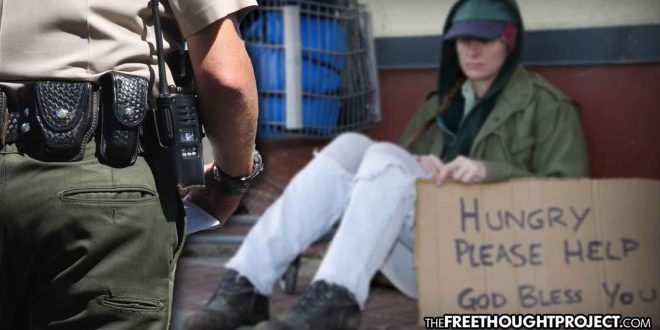According to a bombshell new report, over one third of the events in which an LAPD officer used “force” in the field within the last number of months involved a homeless individual. Indeed, within the third quarter of 2019 alone, force was utilized in relation to a homeless person 217 times. This marks a nearly 27 percent spike from 2018, which saw only 172 such incidents. Reactions in both local government and law enforcement have been decidedly mixed, with many attributing the uptick to the rapidly growing volume of LA’s homeless population, as well as focusing on petty crimes perpetrated by the homeless themselves. Per LAPD homeless coordinator commander Donald Graham: ““There’s going to be more contact between the police and persons experiencing homelessness, and the expected result of that will be increases in uses of force.”
Los Angeles County’s yearly “homeless count” started back in late January. The 2019 count reported a record 58,936 homeless individuals living throughout LA County, 36,300 of which reside in the city of Los Angeles proper — marking drastic increases of 16 and 12 percent over 2018’s figures. The underlying factors behind this rise have been explored ad nauseam; familiar now even to a layman outside the area. A combination of soaring housing prices, faltering mental health facilities, the explosion of cheap street drugs, and several other societal pitfalls have resulted in a “perfect storm” of conditions for a true homelessness crisis. But if the emotional and physical wiles of living outside and cripplingly limited access to basic health care weren’t enough in the way of day-to-day perils for LA’s homeless population to face, they now find themselves on the receiving end of a new threat — one stemming from the very force pledged to protect them.
This troubling report doesn’t include a meaningful accounting of the kind of force used by these officers, but 5 out of the 217 incidents wherein force was put to use in Q3 2019 contained what’s known as a “categorical use of force,” a broad parameter which does count occurrences in which said force caused major injuries. Of the five, specific mention was made of an in-custody fatality, as well as an officer discharging his weapon. On the other end of the spectrum, “force” could also include more minor incidents, like an officer firmly gripping a suspect’s hand to prevent him from shifting away. Graham claims that the type of force applied makes all the difference, stating: “I’d look at… If there is a specific increase in, say, baton usage on the homeless population, obviously that would be very concerning.”
But regardless of the level of force being utilized, others claim this report marks a concerning trend, particularly regarding how disproportionate this kind of rough treatment is for homeless populations as opposed to other groups. Indeed, it might mark a turning point in the city’s usage of law enforcement as a means of addressing the homelessness crisis — an approach which has seen rapidly diminishing returns. Just last year, there were calls to fire an LAPD detective who shot and severely injured a homeless military veteran on Skid Row. What’s more, the detective in question was later found to be both off-duty and intoxicated at the time of the shooting. This was just one of the more attention-grabbing incidents involving the homeless being victimized, but it’s clearly becoming something of a pattern.
One practical explanation for this spike has to do with the fact that homeless people are more likely to interact with police officers since they, by nature, live outside. Thereby, normal, human acts like sleeping, sitting, using the bathroom and eating can be deemed criminal when taken in a public context. As a means of addressing this, Commander Graham stated that he would try to spread awareness among the LAPD of the struggles faced by homeless individuals, as well as advising them on de-escalation tactics to avoid force, even going so far as to contact the LA Homeless Services Authority for tips and strategies.
Nevertheless, the fault lines of the homeless experience continue to grow more precipitous. 2019 saw a 19 percent increase in crimes being reported where the victim was without a home. Some of this is environmental, being that violent crime is more common in the geographical regions where the homeless are commonly situated. Nevertheless, the LAPD does not appear to be issuing a public condemnation of their harsher tactics, nor do they plan to scale back this flawed approach in any meaningful sense. “Individuals experiencing homelessness… that are committing crimes… in the neighborhood will have the attention of the Los Angeles Police Department,” says LAPD Chief Michael Moore. “Experiencing homeless, while a life challenge, does not mean a person can break the law.” But this pat response doesn’t answer the core impossibility of the homeless’ dilemma: what is one to do when the very inherent nature of their survival is, in itself, deemed a crime?
Written by: Dash Finley





